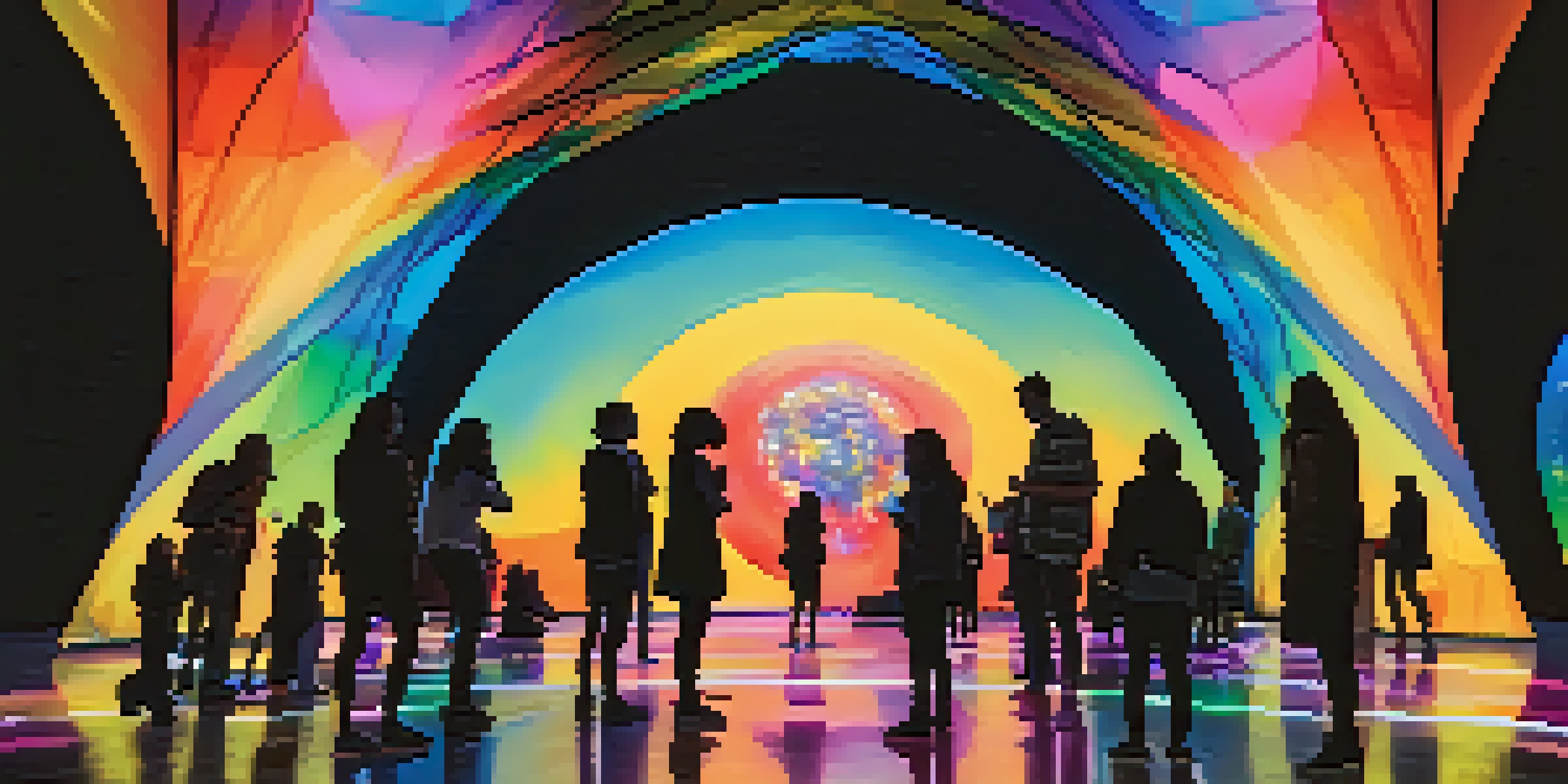Experiential Art: Engaging All Senses Through Sound and Vision

What is Experiential Art and Why Does It Matter?
Experiential art invites viewers to engage with their surroundings in a multi-sensory way, transcending traditional boundaries of art. It combines visual elements with other sensory experiences, such as sound, touch, and even smell, to create a fully immersive encounter. The importance of this art form lies in its ability to connect emotionally with audiences, fostering a deeper understanding of the artwork and its message.
Art is not what you see, but what you make others see.
Think of it as stepping into a painting rather than just looking at it. For instance, installations like Yayoi Kusama's infinity rooms not only please the eye but also evoke feelings of wonder and introspection. This multidimensional approach encourages active participation, transforming passive spectators into engaged participants.
As we navigate a world filled with distractions, experiential art offers a refreshing escape, allowing us to reconnect with our senses. This kind of engagement can lead to new interpretations and personal connections, enriching our overall experience of art and culture.
The Role of Sound in Experiential Art
Sound plays a pivotal role in experiential art, enhancing the emotional landscape of an installation. By incorporating music, spoken word, or environmental sounds, artists can create atmospheres that evoke specific feelings or memories. For example, a serene soundscape of flowing water can transport visitors to a tranquil setting, while chaotic urban sounds might provoke feelings of anxiety or excitement.

Consider how a simple sound can change your perception of a visual piece. An installation that features visuals of a bustling city paired with the sounds of honking cars and chatter can immerse viewers in that environment, making them feel as if they are part of the scene. This synergy between sound and sight is what makes experiential art so powerful.
Experiential Art Engages the Senses
This art form combines visual, auditory, and tactile elements to create immersive experiences that invite emotional connections.
Moreover, sound can prompt interaction, inviting viewers to explore the space further. By encouraging visitors to engage with both the visual and auditory elements, artists create a memorable experience that lingers long after the visit.
Visual Elements: The Heart of Experiential Art
Visual components are foundational to experiential art, serving as the first point of engagement. Artists often use vivid colors, dynamic shapes, and innovative materials to draw audiences in and provoke curiosity. The visual experience sets the stage, inviting viewers to explore and interact with the piece in a meaningful way.
Every artist dips his brush in his own soul, and paints his own nature into his pictures.
Take, for instance, the works of Olafur Eliasson, whose installations often play with light, shadow, and reflections. His pieces, like 'The Weather Project,' combine large-scale visuals with immersive environments, allowing visitors to experience art on multiple levels. This visual impact is crucial as it lays the groundwork for the sensory exploration that follows.
Ultimately, the visual aspect of experiential art not only captivates but also challenges perceptions and invites interpretations. By creating a striking visual landscape, artists encourage us to reconsider our relationship with the world around us.
Interactive Elements: Engaging Visitors Directly
Interactivity is a hallmark of experiential art, breaking down the barriers between the artwork and the viewer. This direct engagement invites participants to influence or alter the artwork, making each experience unique. For example, installations that allow visitors to manipulate light or sound can create a sense of ownership and involvement.
Imagine an art piece where visitors can step on different tiles to produce various sounds, transforming them into active creators rather than passive observers. This not only enhances the experience but also encourages collaboration and social interaction among visitors. Such dynamic environments cultivate a sense of community and shared experience.
Interactivity Enhances Personal Connection
By allowing viewers to actively participate in the artwork, experiential art transforms passive observation into meaningful engagement.
Moreover, interactive elements often lead to unexpected discoveries, prompting visitors to explore and engage in ways they might not have anticipated. By fostering this sense of playfulness, experiential art becomes a platform for personal expression and creativity.
Exploring the Emotional Impact of Experiential Art
Experiential art has a profound emotional impact, often evoking feelings that extend beyond the visual or auditory experience. The combination of sound, imagery, and interactivity can trigger memories, provoke thought, or inspire joy. This emotional resonance is what sets experiential art apart and makes it so compelling.
For instance, an installation that combines nostalgic visuals with evocative music can transport participants back to cherished moments from their past. This reflection on personal experiences fosters a deeper connection between the viewer and the artwork, transforming the act of viewing into a journey of self-discovery.
The emotional depth of experiential art highlights its ability to resonate on a personal level. In a world where art can sometimes feel distant or inaccessible, these immersive experiences invite us to engage, reflect, and connect with our emotions in meaningful ways.
The Future of Experiential Art in a Digital Age
As technology continues to evolve, so does the landscape of experiential art. Virtual reality (VR) and augmented reality (AR) are opening new avenues for artists to create immersive experiences that transcend physical boundaries. This digital shift allows for limitless possibilities, enabling audiences to engage with art in innovative ways.
Imagine walking through a VR installation where the visuals and sounds change based on your movements, creating a truly unique experience each time. This integration of technology not only enhances the sensory experience but also challenges our understanding of what art can be. The future of experiential art lies in this fusion of the physical and digital realms.
Technology Shapes Art's Future
The integration of virtual and augmented reality is expanding the possibilities of experiential art, making it more inclusive and dynamic.
Additionally, as more artists embrace these technologies, we can expect to see a broader range of voices and perspectives represented in the art world. This democratization of art through digital platforms will foster greater inclusivity and diversity, enriching the experiential art landscape for all.
How to Experience Experiential Art Yourself
Experiencing experiential art can be one of the most fulfilling activities, but knowing where to start can be a challenge. Begin by seeking out local installations or exhibitions that emphasize interactive and multi-sensory elements. Many museums and galleries now feature sections dedicated to experiential art, making it easier for you to engage with this captivating form.
When visiting an installation, approach it with an open mind and a willingness to participate. Don’t hesitate to touch, listen, or even move within the space. Allow yourself to be immersed in the experience, letting the sounds and visuals wash over you as you explore the art in your own way.

Finally, consider documenting your experiences through photos or journals. Reflecting on how the art made you feel can deepen your appreciation and understanding of not just the piece but also the broader themes it represents. Engaging with experiential art is as much about personal connection as it is about the artwork itself.